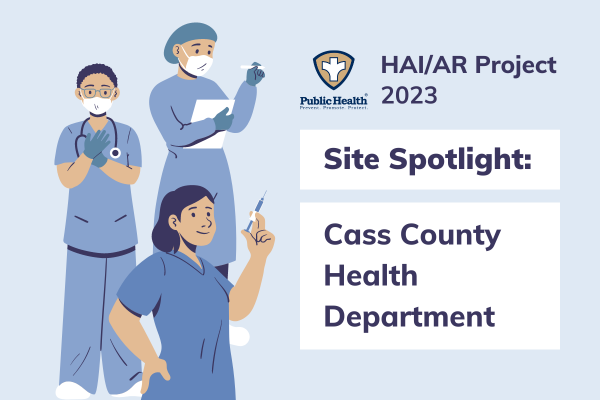The National Association of County and City Health Officials (NACCHO), the voice of the country’s nearly 3,000 local health departments, with support from the Centers for Disease Control and Prevention (CDC), Division of Healthcare Quality and Promotion, awarded eleven local health departments with funding to support the Local Health Department Healthcare-Associated Infections and Antimicrobial Resistance (HAI/AR) project. These funds supported their ability to pilot and implement the CDC (Interim) Local Health Department Strategy for HAI/AR.
HAIs are among the leading causes of preventable deaths in the United States. The CDC estimates that one in 31 hospital patients are infected with at least one HAI, and AR is a major public health threat that compounds the challenge of HAIs. Antimicrobial-resistant infections cause more than 35,000 deaths each year, and nine of the top 18 infections considered to be the highest AR threats are often associated with healthcare settings.
The selected local health departments used the CDC (Interim) Local Health Department Strategy for HAI/AR to enhance the capacity of HAI/AR prevention and response, including through conducting infection control assessments, strengthening antimicrobial stewardship efforts, improving laboratory coordination, and enhancing HAI/AR data reporting and access. They also coordinated with stakeholders at the local and state levels to advance these efforts.
We asked our HAI/AR pilot project sites to reflect on their experiences and lessons learned since joining our project. Here is what one of our sites, Cass County, shared with us. A standalone version of their blog post can be found here.
Cass County Health Department
Bryanna Cloninger and Alexandra Taberski were the primary program staff for the Cass County Health Department during the Pilot Project. Bryanna has extensive knowledge relating to HAI/AR work and COVID-19. She was the lead Contact Tracer and Point of Contact for long-term care facilities throughout the pandemic. She provided support in the form of communicating updated guidance, testing, and all aspects of contact tracing/ reporting. Bryanna also provided assistance for all prevention needs such as tracking of illness and PPE access and usage. Alexandra works closely with local resources and Emergency Preparedness, which proved helpful within this project when trying to access EP procedures and reporting structures.
HAI/AR Background
“As an agency, Cass County Health Department has not had much capacity working in HAI/AR with partners in the past. HAI/AR activities were generally practiced within each individual facility. In the midst of the COVID-19 pandemic, it was realized that there was a greater need for us as a health department to be more involved. To us, this was in the form of assistance with quality tracking, education, and prevention.
We initiated our HAI/AR work with COVID-19-related funding and were fortunate enough to continue with our current funding. We started with our obvious issue being positive COVID-19 cases and morbidity within our long-term care facilities. There were many cases and deaths within the two facilities in our county. HAI/AR program staff began disseminating training materials to staff and working with the Directors of Nursing to be able to have a more in-depth monitoring system for healthcare-associated infections.
“This funding opportunity helped us realize that there wasn’t an efficient way to evaluate occurrences of HAIs or AR in our jurisdiction in the past.”
We are a county without a hospital or emergency center, which means that the state tracking systems do not accurately depict our county data. It was also found that on a facility level, there is minimal tracking for HAIs in-house. We have established an open line of information-sharing and a full updated list of local partners that assist with our work. Program staff have also partnered with state HAI/AR to conduct ICAR assessment with the hope of identifying and solving any issues. Things that were addressed were medication storage, proper cleaning of glucometers, proper procedures when seeing a patient, and use of disinfectants. While we have done a multitude of activities to further our HAI/AR work, we have focused mostly on building partnerships with our long-term care facilities, primary care clinics, and state HAI/AR program.”
Networks with Public and Private Partners and Healthcare Facilities
“Our HAI/AR program staff has continued to see progress in our partnerships, old and new. While there are partners that we have been working side-by-side with for several years, there have also been new partnerships formed through our advanced work. CCHD has used this funding opportunity to grow our partner network and collaborate on how to best serve the facilities we work with. When working with our state HAI/AR over the last year, it was identified that local access to the National Healthcare Safety Network (NHSN) was limited and not typically explored. This led to further conversations with partner facilities to identify how they are currently, or should be, monitoring healthcare-associated infections and antibiotic resistance. This engaged a new level of conversations between us.
While we work well together now, the functional working relationship has not always been present. This was due to a lack of resources at the LHD level and a general lack of communication. It was during the COVID-19 pandemic that a new line of communication emerged. We improved communication with our local HAI/AR resources, as well as gathered local emergency preparedness resources. This became a great need in the midst of COVID-19 due to the all-hands-on-deck approach that was utilized.
We are very proud of the work that has been done and we look forward to making greater progress in the future. There is still plenty of work to be done, but we plan to continue our efforts. We have placed a lot of value on the continuation of our work, as it appears to be beneficial within our facilities. They are becoming more aware of prevention, mitigation, and treatment and taking necessary steps to be as informed as possible. As we continue to learn and be a resource, they will do the same.”



